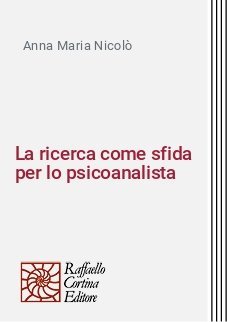Anna Maria Nicolò
Titoli dell'autore
La ricerca come sfida per lo psicoanalista
rivista: La Rivista di Psicoanalisi
fascicolo: Rivista di Psicoanalisi 2018/2
di Anna Maria Nicolò
La ricerca in psicoanalisi costituisce una sfida per gli psicoanalisti a causa di forti elementi di invalutabilità nella relazione analitica. Gli strumenti dell’analista potrebbero essere ritenuti non utilizzabili dalla scienza empirica, tuttavia esistono altre possibilità di studio degli eventi emotivi. C’è una similitudine tra il funzionamento mentale del ricercatore e quello dell’analista perché dubbio, curiosità e umiltà sono qualità importanti sia per fare ricerca che per essere analisti. La ricerca non è solo un obiettivo ma diventa un modello di funzionamento della mente, un attivatore della sua trasformazione e si costituisce come un veicolo per arrivarci. Il lavoro per esempio in gruppi di ricerca, a cui possono partecipare analisti di orientamento diverso e con differenti gradi di esperienza e formazione, favorisce un continuo confronto e lo sviluppo di una cultura di verifica tra pari.
Parole chiave: Complessità, gruppi di ricerca, istituti di psicoanalisi, ricerca, ricerca clinica, training.
Research as a challenge for the psychoanalyst. Research in psychoanalysis represents a challenge for psychoanalysts due to the many elements that cannot be evaluated in an analytic relationship. An analyst’s tools might not be considered utilizable by empirical science, but there might be other ways to study emotional events. A researcher’s and an analyst’s mental functioning are similar because doubt, curiosity, and humility are important qualities both for doing research and for being a good analyst.
Research is not only a goal but becomes a model for the mind’s functioning, an activator for its transformation and can become a tool for reaching it. Work in groups made up of analysts of various schools and with varying degrees of training and experience can favor constant confrontation and contribute to developing a culture of inquiry among peers.
Keywords: Clinical research, complexity, psychoanalytical institutes, research, research groups, training.
La recherche comme défi pour le psychanalyste. La recherche en psychanalyse est un défi pour les psychanalystes à cause des forts éléments de subjectivité dans la relation analytique. Les outils de l’analyste pourraient être considérés comme n’étant pas utilisés par la science empirique, mais il existe d’autres possibilités pour étudier les événements émotionnels. Il y a une similitude entre le fonctionnement mental du chercheur et celui de l’analyste car le doute, la curiosité et l’humilité sont des qualités importantes à la fois pour faire de la recherche et pour être des analystes. La recherche n’est pas seulement un but mais devient un modèle du fonctionnement de l’esprit, un activateur de sa transformation et constitue un véhicule pour y parvenir. Par exemple, le travail dans des groupes de recherche, auxquels peuvent participer des analystes de différentes orientations et avec différents degrés d’expérience et de formation, favorise un dialogue continu et le développement d’une culture d’évaluation parmi les pairs.
Mots clés: Complexité, formation, groupes de recherche, instituts de psychanalyse, recherche, recherche clinique.
La investigación como desafío para el psicoanalista. La investigación en psicoanálisis es un desafío para los psicoanalistas debido a los elementos que no resultan evaluables en la relación analítica. Las herramientas del analista podrían ser considerados como no utilizables para la ciencia empírica; no obstante, existen otras posibilidades de estudio de los hechos emotivos. Hay una similitud entre el funcionamiento mental del investigador y el del analista porque duda, curiosidad y humildad son calidades importantes tanto para hacer investigación como para ser analistas. La investigación no es únicamente un objetivo, sino también un modelo de funcionamiento de la mente, un activador de su transformación y se constituye en vehículo para llegar hasta allí. Por ejemplo, el trabajo en equipos de investigación, en los que participan analistas de orientaciones diferentes y con distintos grados de experiencia y formación, favorece una constante confrontación y el desarrollo de una cultura de comprobación entre iguales.
Palabras Clave: Complejidad, equipos de investigación, institutos de psicoanálisis, investigación, investigación clínica, training.
Die Forschung als Herausforderung für den Psychoanalytiker. Die Forschung in der Psychoanalyse stellt aufgrund starker Elemente der Immensurabilität in der analytischen Beziehung eine Herausforderung für den Psychoanalytiker dar. Die Instrumente des Analytikers können von der empirischen Wissenschaft als nicht verwertbar erachtet werden, dennoch existieren andere Möglichkeiten der Erforschung emotionaler Ereignisse. Es besteht eine Ähnlichkeit zwischen dem mentalen Funktionieren des Wissenschaftlers und dem des Analytikers, da Zweifel, Neugier und Bescheidenheit wichtige Eigenschaften sowohl für die Forschungs- als auch für die Analytikertätigkeit sind. Die Forschung ist nicht lediglich ein Ziel, sie wird zu einem Funktionsmodell des Verstandes, einem Auslöser seiner Transformation und Mittel, dorthin zu gelangen. Die Arbeit in Forschungsgruppen beispielsweise, denen Analytiker verschiedener Richtungen und unterschiedlichen Erfahrungs- und Ausbildungsstandes angehören können, fördert eine stetige Gegenüberstellung und die Entwicklung einer Verifikationskultur unter Gleichen.
Schlüsselwörter: Forschung, Forschungsgruppen, Institute für Psychoanalyse, klinische Forschung, Komplexität, Training.
Trasformazione del dolore e corpo ripudiato
rivista: La Rivista di Psicoanalisi
fascicolo: Rivista di Psicoanalisi 2016/4
di Anna Maria Nicolò
Nell’anoressia, l’annullamento del piacere e del dolore rimandano a un mondo interno che si vuole combattere, anzi nelle situazioni più gravi annullare. Il corpo è l’ultimo baluardo a cui aggrapparsi. Si produce così una fame di stimoli sensoriali che si sostituisce al pensare. Alcune delle patologie attuali, come l’anoressia, ci mostrano come a fronte di una difficoltà nella costruzione dell’identità si ricorra a un apparire al posto dell’essere. In questi funzionamenti è il mimetismo a essere l’obiettivo. Questo mimetismo dona paradossalmente un’identità. Tramite «l’identità estetica», così costruita, si dribbla il dolore di soggettivarsi o si fa fronte ai gravi conflitti che possono accompagnare la costruzione del Sé. L’identità estetica, comune a molti funzionamenti attuali, di cui l’anoressia rappresenta uno degli esempi, si presenta come cerniera tra la psicopatologia individuale e il funzionamento sociale.
Parole chiave: Adolescenza, anoressia, identità estetica, corpo, trasformazione del dolore.
The Transformation of Pain and the Rejected Body. In anorexia, the annihilation of pleasure and of pain harks back to an internal world that one wants to fight against – indeed, in the most serious situations, to annihilate. The body is the ultimate rampart to cling to. Thus, a hunger for sensorial stimuli is produced and is substituted for thinking. Some of the current pathologies, such as anorexia, show us that, in coping with a difficulty in identity construction, one makes recourse to appearances in place of being. In this type of functioning, it is the mimicry of being that is the objective. This mimicry paradoxically grants an identity. Through «aesthetic identity», constructed as such, one evades the pain of becoming a subject or of facing the serious conflicts that can accompany construction of the self. Aesthetic identity, common to many current types of functioning, of which anorexia represents an example, is presented as a bridge between individual psychopathology and social functioning.
Keywords: Adolescence, aesthetic identity, anorexia, body, transformation of pain.
Transformation de la douleur et corps répudié. Dans l’anorexie l’annulation du plaisir et de la douleur renvoyent à un monde intérieur qu’on veut combattre, et, dans les situations les plus graves, annuler. Le corps est le dernier bastion auquel s’agripper. Se produit ainsi une faim de stimules sensoriels qui remplace la pensée. Certaines des pathologies actuelles, telles que l’anorexie, nous montrent comment, face à des difficultés dans la construction de l’identité, on essaye d’apparaître plutôt que d’être. Dans ces fonctionnements, c’est le mimétisme à être le but. Ce mimétisme donne paradoxalement une identité. Grâce à «l’identité esthétique», ainsi construite, on écarte la douleur de subjectivation ou les graves conflits qui peuvent accompagner la construction de soi. L’identité esthétique, commune à de nombreuses fonctionnements existants, y compris l’anorexie, se présente comme un lien entre la psychopathologie individuelle et le fonctionnement social.
Mots-clés: Adolescence, anorexie, corps, identité esthétique, transformation de la douleur.
Transformación del dolor y cuerpo rechazado. En la anorexia la anulación del placer y del dolor hacen referencia a un mundo interior que se quiere combatir, e incluso, en la peores situaciones, anular. El cuerpo representa el último bastión al cual agarrarse. De esta manera, se genera un hambre de estímulos sensoriales que se sustituye al pensamiento. Algunas patologías actuales como la anorexia muestran cómo el recurso a aparecer en lugar de ser, cubre una dificultad de construir la propia identidad. En este funcionamiento el objetivo es el mimetismo. Este mimetismo da paradójicamente una identidad. Al construir una «identidad estética» se esquiva el dolor de subjetivarse o se encaran los graves conflictos que pueden acompañar la construcción del Sí mismo. La identidad estética, que acomuna muchos funcionamientos actuales, de los cuales la anorexia es un ejemplo, se presenta como una conexión entre la psicopatología individual y el funcionamiento social.
Palabras claves: Adolescencia, anorexia, identidad estética, cuerpo, transformación del dolor.
Transformation des Schmerzes und abgelehnter Körper. In der Magersucht weist die Neutralisierung der Lust und des Schmerzes auf eine innere Welt hin, die bekämpft, gar ausgelöscht wird. Der Körper ist das letzte Bollwerk an dem man sich festhält. Eine Gier nach sensorischen Reizen wird produziert, die das Denken ersetzt. Einige der aktuellen Pathologien – so die Anorexie – zeigen uns, wie aufgrund der Schwierigkeit, die eigene Identität aufzubauen, zum Erscheinen an Stelle des Seins gegriffen wird. In dieser Funktionsweise ist Tarnung das Ziel. Paradoxerweise verleiht die Tarnung eine Identität. Durch die so aufgebaute «ästhetische Identität» umgeht man den Schmerz der Subjektivierung oder man setzt sich mit schweren Konflikten auseinander, die den Aufbau des Selbst begleiten. Die ästhetische Identität, die vielen aktuellen Funktionsweisen inne ist, von denen die Magersucht ein Beispiel ist, stellt eine Verbindung von individueller Störung und sozialer Funktionsweise dar.
Schlüsselwörter: Adoleszenz, Anorexie, ästhetische Identität, Körper, Transformation des Schmerzes.
 ita
ita
 Eng
Eng





